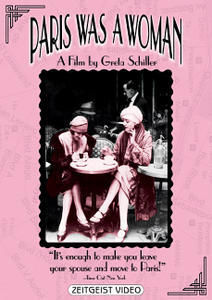 |
| Paris Was a Woman (1996) |
Paris Was a Woman is a documentary about artists living in Paris during the time between the wars–specifically in the 1920s. Paris has always been a place for artists, but at this time, Prohibition, inexpensive living, and a general openness to different lifestyles and art made American women flock to the Left Bank area of the city. The film looks at Gertrude Stein, Alice Toklas, Colette, Djuna Barnes, Berenice Abbott, Gisele Freund, and Janet Flanner, among others.
The film will certainly be of interest to fans of these writers, artists, and other literary figures—in particular of Stein. There is home movie footage that most of us have probably never seen, and interviews with people intimate with the women in their Parisian heyday–and a lot of information from a housekeeper. One problem with the film, though, is that it’s really about lesbians living in Paris in the 1920s, which perpetuates the untruthful equation of lesbianism and feminism. Part of the problem might be that the film was released in 1995, and mainstream attitudes have changed to the extent that it may no longer be necessary to disguise a film about lesbian artists. In other words, I would like the film better if it wasn’t pretending to be something other than what it is.
In terms of quality, the film has its high and low points. One of my favorite things was a map of the homes, shops, and meeting places of the women—updated each time someone new was introduced. This visual really drives home the point about their close proximity, and makes me wonder how many neighborhoods—full of amazing artists—exist today. There are probably many, but with our fragmented modern lives, I don’t know of any. The quality of the film left something to be desired (making it look older than it is), and it seemed pretty disorganized, overall. This likely has to do with the fact that Paris Was a Woman was first a book, and was then turned into a documentary.
Perhaps the best part of the film was its emphasis on two women and their bookshops. Sylvia Beach was the owner of Shakespeare & Company, perhaps best known for publishing the first edition of James Joyce’s Ulysses, which had been deemed obscene, making it unpublishible by mainstream houses. A sad irony is that, later, Joyce never paid Beach, who was virtually bankrupted by her action. Adrienne Monnier lent books to women who couldn’t afford to purchase them from her bookstore, La Maison des Amis des Livres, which was located across the street from Shakespeare & Company. Monnier and Beach also translated T.S. Eliot’s “The Lovesong of J. Alfred Prufrock” into French for the first time.
Women nurturing—and even launching—the careers of men is nothing new. I think we often forget–or even never learn–to what extent, however. Ernest Hemingway served as an errand boy to Gertrude Stein before he became a published writer. She also bought paintings by Pablo Picasso when few other people would purchase his strange work. Despite my formalist reservations about the film (organization, film quality, clearness of content), it was amazing to see such a strong community of female artists living, working, and even making love together. It teaches us not only about these particular women, but about a city, an era, and, in some sense, about how to be an artist–as all good art, on some level, should.
